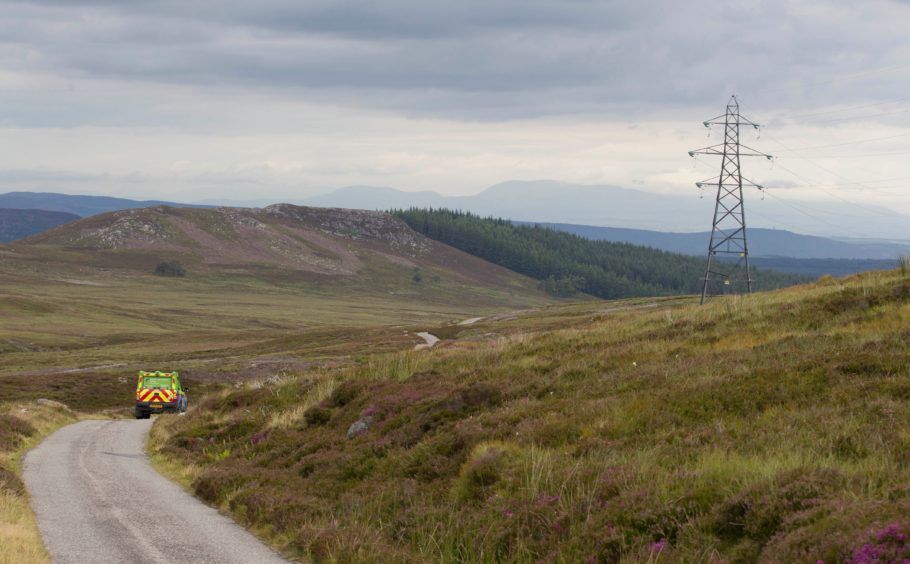
Current plans to reinforce the power line between Fort Augustus and the Western Isles, via Skye, reminded me of the controversy that arose when the link was created in the 1980s.
Until then, electricity supply in the islands depended on two diesel-fueled power stations at Stornoway and Loch Carnan in South Uist. With industrial activity, particularly at the Arnish fabrication yard, expected to increase, the need arose for a more robust power supply.
The original Hydro Board proposal was to run the line through Glenshiel, close to the scenic main road leading to Skye. Some of the land was owned by the National Trust for Scotland. Put these two factors together and it was scarcely surprising that a great furore arose and the plan was eventually amended.
Instead of going through Glenshiel, the route runs further south via Glen Quoich, which is largely out of sight and out of mind – though this was not the view of those who objected to a pristine environment being defiled by an overhead power line.
However, the scheme got the go-ahead after a public inquiry and for three decades has been the main source of power for Skye and the Outer Isles. Two sub-sea cables run from Ardmore on the Waternish peninsula across to Harris and South Uist respectively.
When indignation over Glenshiel was at its height, I advanced an alternative idea which, in retrospect, I’ve always thought was one of my better ones. Instead of linking the Western Isles to the National Grid, could the islands have become the national test-bed for renewable energy?
The diesel-powered stations were going to continue as back-up anyway. Indeed, they fulfill that role to this day. When, as occasionally happens, there is a problem with the line from Fort Augustus or an under-sea cable, the old stations crank back into action.
But this was the 1980s. Renewables were in their infancy and the Hydro Board was heavily into big engineering solutions. So my helpful suggestion did not get much traction. Glen Quoich emerged as the alternative option. Glenshiel was spared and almost everyone was happy.
The downside was that there was no imperative to drive forward renewables in the Western Isles and that enigma has persisted through the decades. While “the best renewable resources in Europe” are much spoken of, very little has actually happened – and nothing at all which might be transformational.
The subsea cables have bought in power to keep the Hebridean lights on, but lack the capacity to export power generated within the islands. The current upgrade proposals from SSE/SHETL will not change that. Power generated from within the Western Isles will remain stranded, unless…
The big “unless” involves the long-awaited interconnector between Lewis and the mainland which is required to support wind farm developments on the island. There is now a consented capacity of 400 megawatts but nowhere to send it. As long as that is the case, nothing will be built.
There are no early prospects for resolution. While the smaller schemes on Lewis secured offers of contract for difference support in the last round, the big one did not. Without it, the megawatts do not add up to justify an interconnector in the eyes of Ofgem.
While efforts to square that circle continue, perhaps it is again time to look for “Plan B”. Is there another route by which wind-generated power could be transported and sold? Could hydrogen be the magic word?
The Western Isles Council is developing a hydrogen plan within the islands’ own energy requirements. Perhaps it would also be worth looking further afield, to the Heligoland islands, 45 miles off the German coast for a different perspective. They have a population of just 1,200 but are not short of big ideas.
Their ambition is to become centre of an offshore wind-to-hydrogen hub on a multi-gigawatt scale, feeding off offshore wind developments along the German coast. The mayor, who is leading the project, predicts: “In less than 10 years, green hydrogen from the North Sea will be normal and an integral part of the national hydrogen strategy”.
A “national hydrogen strategy”? It might be useful to have one of these. Or how about the European Commission’s hydrogen strategy which aims to create a market by 2050 that will support up to a million jobs and “help to reach greenhouse gas reduction targets in sectors that are otherwise hard to decarbonise”?
Heligoland is far from alone in planning for the necessity of “green hydrogen”. Portugal and the Netherlands recently produced their own strategies while Saudi Arabia has announced the “world’s largest green hydrogen plant” to fuel global bus and truck fleets.
Already, one begins to have the impression of another boat being missed. Just as in the 1980s, the Western Isles would be the ideal location to be at the centre of such a strategy for Scotland and the UK, rather than on the edges.
Not only are there existing onshore consented wind projects but also sites west of the Hebrides earmarked for floating wind. Or will, once again, Scottish green energy potential float off into the welcoming arms of Denmark, Spain and Germany? (It should not escape notice that the 103 turbines for SSE’s Shetland bonanza will be built in Denmark).
Nobody questions the need for the Fort Augustus-Ardmore link to the Western Isles to be strengthened but it should be more than a passing thought that, on its own, it will do nothing to resolve the dichotomy between potential and reality for the islands as a source of green power.
After decades of merry-go-round, maybe it’s time to look to Heligoland.
Brian Wilson is a former UK energy minister